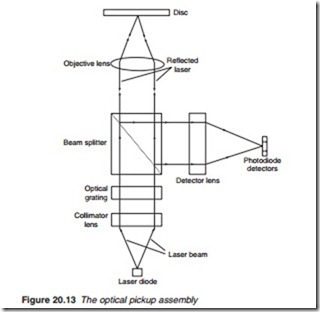The optical pickup head
Figure 20.12 shows a simplified diagram for a front end of a DVD player. The optical pickup unit (OPU), also known as the optical head, extracts the data from the DVD disc using a laser beam and then converting the
reflected laser beam into an electric waveform known as the radio frequency (RF) or high-frequency (HF) signal. The RF signal is an analogue signal which, following analogue-to-digital conversion, is processed by the RF processor on its way to the signal-processing unit to re-produce the origi- nal video, audio and other control and search information. The OPU also provides a number of other outputs, A, B, C, D, etc. to be used to ensure accurate focusing, tracking and speed control of the DVD disc. The RF processor also provides the necessary focus, tracking and other control signals.
The OPU is one of the most critical parts of a DVD player. It combines the LD which generates the laser beam, photodiode array to detect the reflected laser beam as well as all necessary lenses and mirrors in a single integrated device. It generates the laser beam, ensures that the beam focuses on and follows the recording tracks, detects the reflected waveform and produces streams of data for processing and control by the DVD player.
The OPU is mounted on an arm placed under the disc along which the pickup head can move in and out to follow a track or read different tracks. The OPU must be able to read the different types of DVD discs (DVD, HD DVD or BD, single-layer or DL) as well as conventional audio CDs. This means that it must have the capability to generate laser beams of different wavelengths: 780 nm infra-red for audio-CDs, 650 nm red laser for DVD- video and 405 nm blue laser for HD DVD and BDs. In addition, it must have the ability to focus at different depths to accommodate single and DL DVD discs.
The main components of a DVD pickup head are illustrated in Figure 20.13. It consists of a LD, a photo-detector array, splitting mirrors, a coil-controlled lens that can move up and down and sideways for focus and
tracking control. The laser beam is generated by a low-power semicon- ductor laser diode, LD. The collimator lens forces the beam to follow a parallel path on its way to the optical grating lens which bends the laser to produce two beams: a main beam for the actual data stream and a side beam for tracking purposes. Before striking the disc, the beam is focused by the objective lens. The laser hits the disc surface and is reflected back towards the objective lens. Provided the beam is accurately focused, the reflected beam returns along the same path as the incident beam towards the beam splitter. The beam splitter turns the reflected beam by 90º to direct it towards the photodiode detector assembly via the detec- tor lens.

